This vegan ham recipe uses a simple technique to create incredibly delicious seitan roasts. It’s packed with the smoky, salty taste of ham and has a chewy, meaty texture!
Serve as is, or with pineapple glaze, for a satisfying center piece that’s great on any occasion. This recipe is perfect for holiday gatherings; I make it every Christmas and Easter!
If you skip the glaze, it’s also fantastic used for protein-packed vegan ham sandwiches.
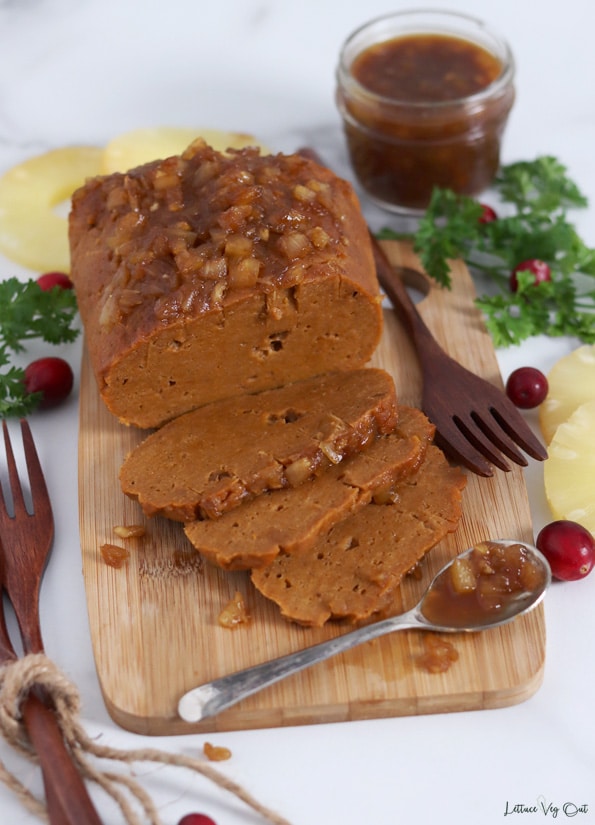
This post contains affiliate links (including Amazon Associates) and I earn from qualifying purchases.
What is Seitan Ham?
Seitan is a vegan meat alternative made from the protein in wheat flour – gluten!
There are several ways to make seitan, but the easiest is to use vital wheat gluten. This flour is essentially pure gluten protein with starches from the wheat flour removed.
Just mix vital wheat gluten with liquid to create a dough, then bake the seitan. If you’ve never made seitan, know that this is the easiest technique with minimal effort required.
Just add plenty of flavor; vital wheat gluten has no taste on its own. This is good because it allows you to flavor your seitan however you like, including smoky, salty ham!
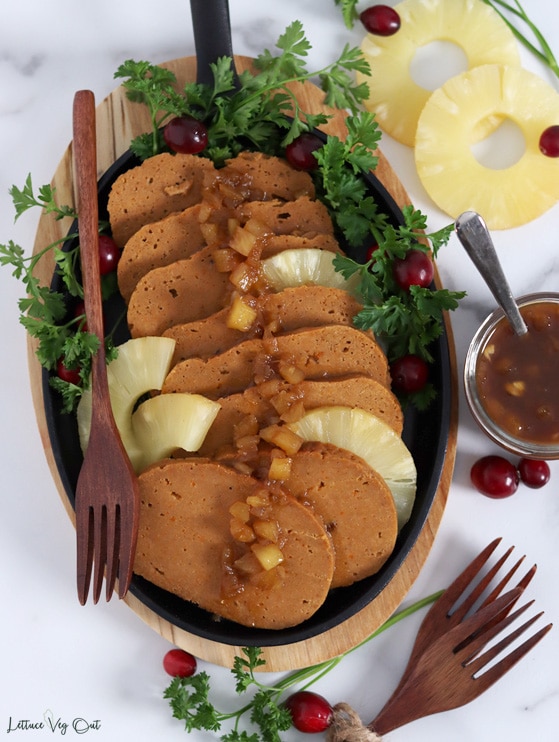
Vegan Ham Roast Ingredients
The base for this recipe, vital wheat gluten, is sold in many grocery stores and bulk food stores (you can also buy it online). All other ingredients should be easy to find, or key staples in your vegan kitchen!
- Vital wheat gluten: Seitan is made from gluten, the protein in wheat flour. Vital wheat gluten (gluten flour) is essentially pure plant-based protein. It creates a firm, chewy, meaty seitan with minimal effort.
- Nutritional yeast: Add savory flavor to your ham with some nutritional yeast.
- Corn starch: This seitan is very firm and chewy, so some starch helps soften the texture slightly. Other starches should work but I haven’t tested them.
- Smoked paprika: Ham is a smoked meat, so this vegan recipe needs to replace that smoky flavor. I use smoked paprika because I don’t like liquid smoke. Alternatively, you could use regular paprika for a mild flavor. If you love smoky flavor, add a drop or two of liquid smoke (I don’t use this ingredient so add cautiously).
- Garlic and onion powder: Some onion and garlic powder help flavor the seitan. Gluten flour has no taste so it’s important to add lots through the seasonings.
- Salt: Ham is a VERY salty meat. To create a tasty meatless alternative, don’t skimp on salt. If you have access to smoked salt, and want some extra smoke flavor, use that!
- Ketchup: Ketchup is a convenient ingredient that brings some color and flavor in this recipe. It also adds some sweetness and a touch of vinegary tang.
- Coconut oil: Smoke, salt and fat are what flavors ham. You’ll have the smoke and salt covered with other ingredients while coconut oil takes care of the fat.
- Tahini: To add extra fat and slightly soften the seitan texture, tahini works great in this recipe. Any nut or seed butter could work, just keep in mind the flavor it’ll add.
- Soy sauce: Extra salt and some fermented flavor adds depth to this recipe. Tamari or a soy-free alternative work as well.
- Dijon mustard: Ham and mustard go well together, so I add some Dijon directly into the recipe for a boost of flavor. Yellow mustard also works.
- Miso paste: Along the same lines as soy sauce, miso paste adds salt and savory, fermented flavor. I typically keep white miso paste on hand, but any type should work in this recipe (though I haven’t tested it out).
- Vegetable broth: Vital wheat gluten needs liquid to create a dough, so I use vegetable broth for the added flavor. I use no-salt-added broth as there’s plenty of salt in other ingredients. If your broth contains some salt, keep that in mind when adding extra salt to this recipe (it may not be necessary).
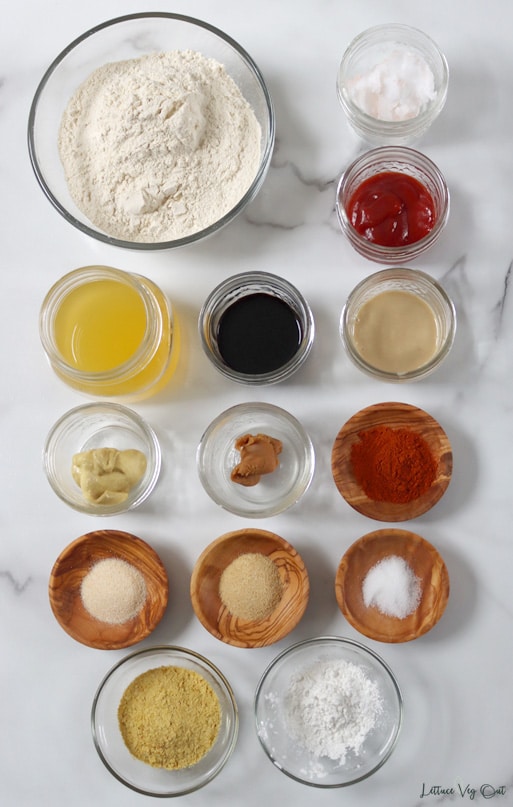
Glaze Ingredients (Optional)
- Pineapple and pineapple juice: As this is a pineapple glaze, you’ll need some pineapple juice. I use canned pineapple juice for this recipe. You could also add cut or crushed pineapple into the glaze for added texture.
- Brown sugar: To help the glaze thicken and create that sticky, glossy glaze texture, brown sugar is a great addition. Maple syrup can also work.
- Corn starch: Thicken the glaze with some corn starch. Other types of starch could work but I haven’t tested them.
- Soy sauce: Balance the sweetness of this glaze with some salt from soy sauce. Tamari or a soy-free soy sauce alternative could also work.
- Dijon mustard: Add extra flavor to the glaze with Dijon mustard. This ingredient is optional, and you could use yellow mustard if preferred.
How to Make a Vegan Ham (Seitan) Roast
The seitan-making technique I use here is as easy as it gets. While you’ll need time to bake your vegan ham, the work involved is as minimal as possible! You don’t even have to chop anything (unless you add pineapple to the glaze).
Read the detailed directions below to learn how to make delicious vegan holiday ham!
Step 1: Whisk Dry Ingredients
Combine your vital wheat gluten with all the dry spices in a large bowl. This includes nutritional yeast, corn starch, smoked paprika, garlic and onion powder and salt.
Whisk until everything is well combined.
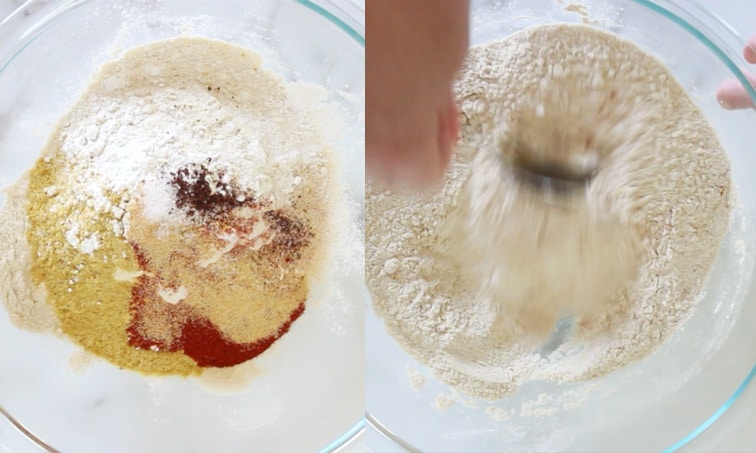
Step 2: Mix Wet Ingredients
In a separate bowl, melt coconut oil. Add the remaining liquid ingredients to your coconut oil and whisk until well combined. This includes ketchup, tahini, soy sauce, Dijon mustard, miso paste and vegetable broth.
The liquid ingredients won’t fully mix (oil prevents that) but do your best. It’s very important to fully dissolve the miso paste in the liquid mixture before adding it to the dry ingredients (you don’t want to end up with a large clump of miso in the final roast).
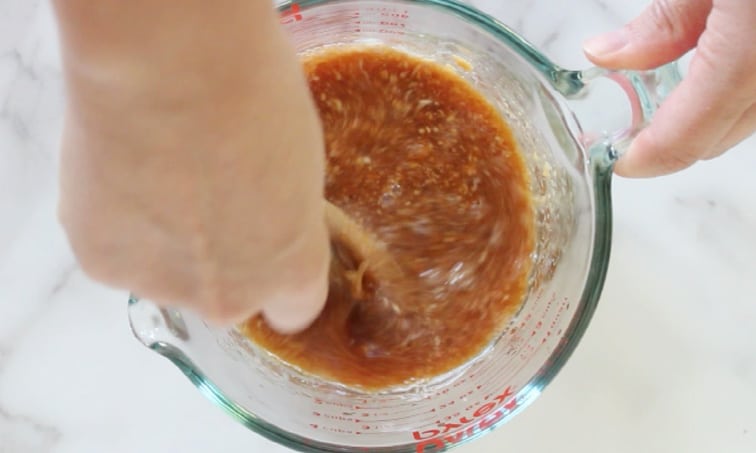
Step 3: Shape Seitan Ham and Bake
Add your liquid ingredients to the dry ingredients, then stir until a ball of dough forms. At this point, use your hand to finish mixing the ingredients together.
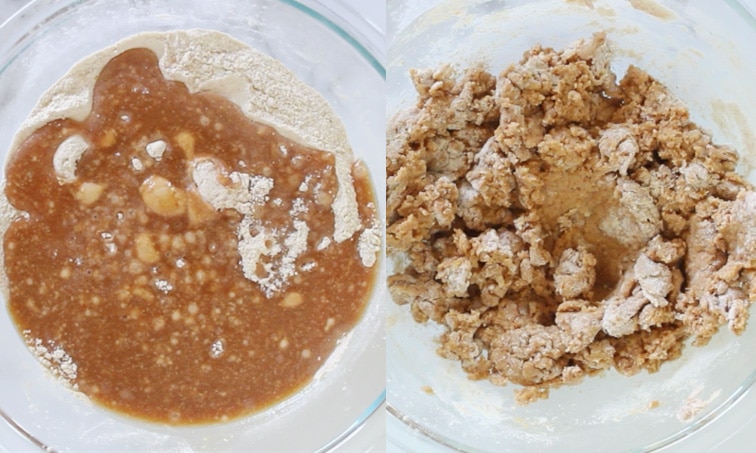
Knead the dough for 1 minute to help the gluten form and ensure all ingredients are well mixed.
Shape the seitan dough into a small ham shape. Place this dough onto a piece of tin foil.
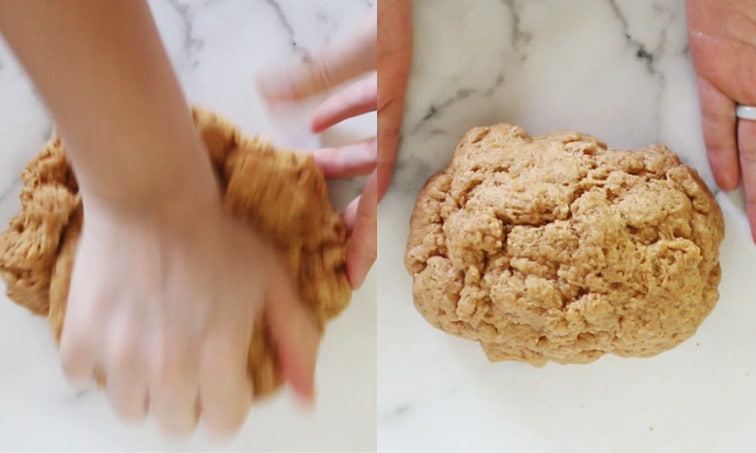
Wrap the seitan tightly, then place its long open edge down onto a second sheet of tin foil. Wrap this second sheet tightly around the first. Seitan expands as it cooks and will create a lighter, airy texture if you let it. Wrapping the seitan creates a firm, chewy texture.
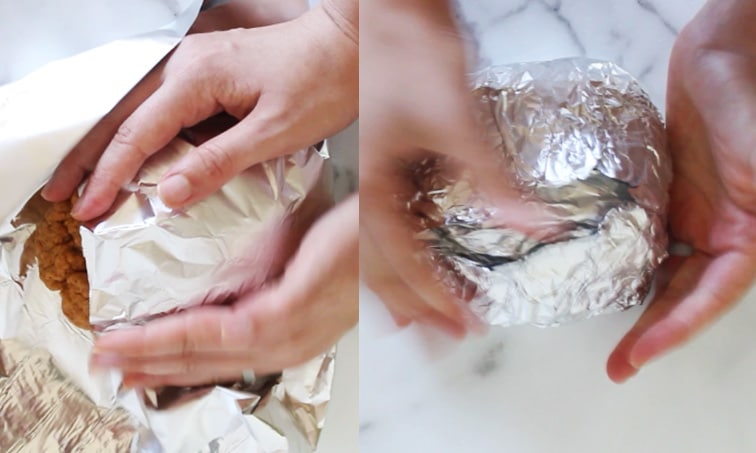
Place the open edge of your second tin foil sheet down onto a baking tray. For easy cleanup, line the baking tray with a silicone mat or parchment paper.
Bake in an oven preheated to 350 °F for 1 hour and 30 minutes, flipping the seitan halfway through. Set a timer to 45 minutes so you don’t forget to flip it.
Once out of the oven, let your seitan rest for 15 minutes before removing its tin foil.
Step 4: Glaze (Optional)
If glazing, chill the ham in your fridge overnight. I recommend making glaze on day 2, before roasting the ham in the glaze (see directions below).
To make glaze, add pineapple juice to a small sauce pot. Whisk corn starch into the pineapple juice until no clumps remain.
You can also add chopped pineapple to the glaze if you want. I typically use canned pineapple for this recipe; since I open the can for juice, it’s easy to then chop ½ cup of pineapple into small pieces (or any size you like).
Add your remaining glaze ingredients to the whisked pineapple juice and starch mixture. This includes brown sugar, soy sauce and Dijon mustard (plus chopped pineapple if using).
Bring this mixture to a boil over medium-high heat, stirring or whisking continuously. Once boiling, lower the heat to medium and continue to stir or whisk until the glaze thickens, about 5 minutes.
This is a thin glaze and doesn’t thicken too much. When ready, it should stick to the whisk/ spoon in a thin coating.

Step 5: Serve Vegan Ham
Once out of your oven, let the seitan rest for at least 15 minutes. At this point, carefully remove the tin foil. You can serve the ham right away, but I recommend chilling your roast before serving.
Once cooled to almost room temperature, refrigerate the seitan in an airtight container (or wrapped in the tin foil it was cooked in). The next day, your seitan will have set into a firm, chewy texture.
Reheat slices in your microwave or place the whole roast into a 350 °F oven for 15-20 minutes. Reheat either wrapped in tin foil or in a small, covered roasting pan.
If using glaze, you must refrigerate the ham overnight. The next day, prepare your glaze. Place the ham (not in tin foil) into a small roasting pan and coat with the glaze. Bake in a 350 °F oven for 15-20 minutes to heat through.
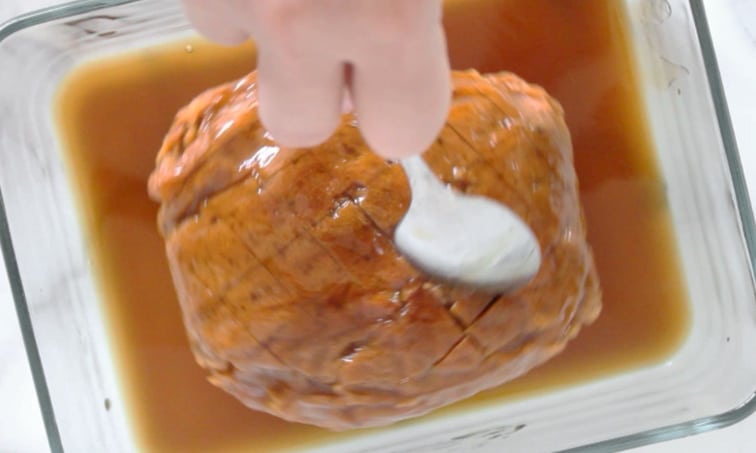
How to Serve a Balanced Vegan Meal
I consider a balanced meal one that contains a good source of plant-based protein, carbohydrates, fats and lots of vegetables or fruits.
This seitan ham is packed with protein and also provides fats. It’s very low in carbohydrates and doesn’t contain vegetables or fruits.
This recipe is meant to directly replace meat. It’s perfect to serve when you have side dishes to go along with this vegan ham. You can also slice it thinly to create delicious sandwiches (or wraps, or add to pizza, pasta or whatever else you’d use ham for).
All classic “roast” fixings are perfect to serve alongside this ham. Potatoes (mashed, roasted, gratin/scalloped), vegetable sides, salads, soups, breads or rolls all work deliciously alongside this ham roast.

How to Store and Reheat Seitan Ham
This recipe is great to make for meal prep if you’re looking for a simple, satisfying protein source.
If you glaze the ham, refrigerate it in an airtight container for up to 4 days. If you don’t use glaze, the ham should last a full week in your fridge.
Glazed seitan ham is perfect to reheat with any of the vegan sides you served it with. If made for a holiday meal, I’m sure there’s other leftovers around too!
You can also use this “meat” to create a delicious ham sandwich. Just slice the ham thinly and add to your favorite bread or bagel along with any sandwich fixings you like. I love yellow mustard, vegan mayo, tomatoes, onion and leafy greens.
Alternately, melt some vegan cheese onto the ham and serve in a buttery, toasted English muffin for a tasty vegan breakfast sandwich. Add tomatoes and lettuce for some veggies too!
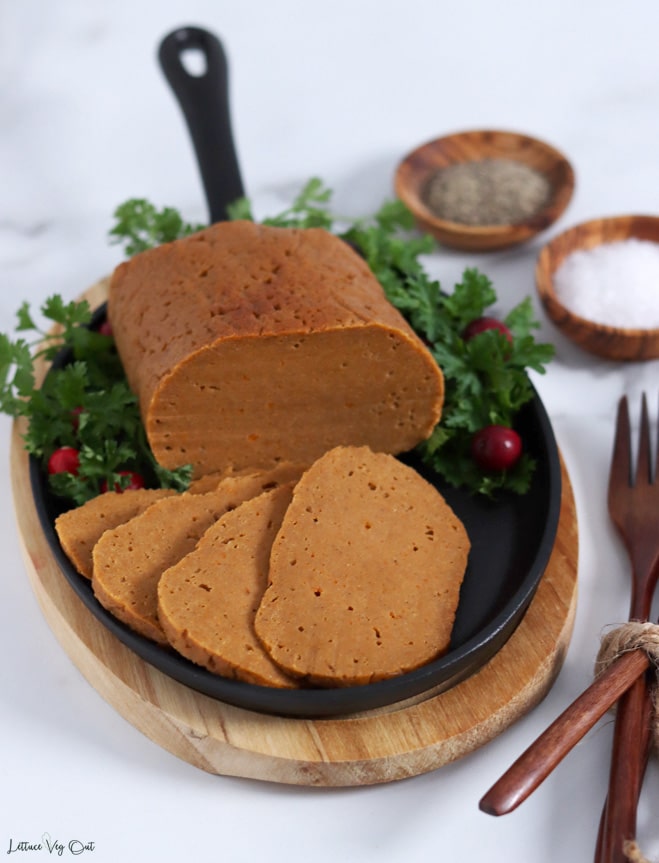
📖 Recipe
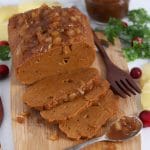
Vegan Ham Roast (Seitan)
Equipment
- Tin foil
- Silicone baking mat , optional (or parchment paper)
- Small sauce pot (for optional glaze)
- Small roasting pan (if making glaze)
Ingredients
Vegan Ham:
- 1 ½ cups vital wheat gluten (gluten flour)
- 2 tablespoons nutritional yeast
- 1 tablespoon corn starch
- ½ tablespoon smoked paprika
- 1 teaspoon garlic powder
- 1 teaspoon onion powder
- ½ teaspoon salt
- 3 tablespoons ketchup
- 3 tablespoons coconut oil , melted
- 2 tablespoons tahini
- 2 tablespoons soy sauce
- 1 tablespoon Dijon mustard
- ½ tablespoon miso paste , white type
- ¾ cup vegetable broth
Pineapple Glaze:
- ½ cup pineapple juice
- ½ cup pineapple pieces , chopped
- ¼ cup brown sugar (or maple syrup)
- 1 tablespoon soy sauce
- 2 teaspoons corn starch
- 1 teaspoon Dijon mustard
Instructions
Step 1: Whisk Dry Ingredients
- In a large mixing bowl, whisk vital wheat gluten with all the dry spices, including nutritional yeast, corn starch, smoked paprika, garlic powder, onion powder and salt.1 ½ cups vital wheat gluten, 2 tablespoons nutritional yeast, 1 tablespoon corn starch, ½ tablespoon smoked paprika, 1 teaspoon garlic powder, 1 teaspoon onion powder, ½ teaspoon salt
Step 2: Mix Wet Ingredients
- In a separate bowl, melt the coconut oil (I use a microwave in 20-30 second intervals).3 tablespoons coconut oil
- Whisk the remaining liquid ingredients with the melted coconut oil, including ketchup, tahini, soy sauce, Dijon mustard, miso paste and vegetable broth.3 tablespoons ketchup, 2 tablespoons tahini, 2 tablespoons soy sauce, 1 tablespoon Dijon mustard, ½ tablespoon miso paste, ¾ cup vegetable broth
- Make sure everything is well mixed (especially the miso paste which takes some time to dissolve; mashing it up with a fork helps).
Step 3: Shape Seitan Ham and Bake
- Add your liquid ingredients to the dry ingredients and stir together until a ball of dough starts to form.
- Once the mixture is too thick to stir, use your hand to knead the dough for about 1 minute. Make sure all the ingredients are evenly distributed.
- Shape the seitan into a slightly flattened ball (see pictures for shape).
- Place your seitan onto a piece of tin foil, then wrap tightly. Place the open edge of your tin foil down onto a second sheet of tin foil and wrap tightly again.
- Place the open edge of your second tin foil sheet down onto a baking tray (lined with a silicone baking mat or parchment paper for easy cleanup).
- Bake in an oven preheated to 350 °F for 1 hour 30 minutes. Flip the seitan halfway through (set a timer for 45 minutes so you don’t forget to flip).
- Once baked, remove the roast from your oven and let it cool for at least 15 minutes.
Step 4: Optional Glaze
- If making glaze, refrigerate your ham overnight. I recommend making the glaze on day 2 before roasting the ham and glaze together.
- Add pineapple juice to a small sauce pot and whisk in corn starch. Make sure no clumps of starch remain.½ cup pineapple juice, 2 teaspoons corn starch
- Next, whisk the remaining ingredients into the pineapple juice, including chopped pineapple pieces, brown sugar, soy sauce and Dijon mustard.½ cup pineapple pieces, ¼ cup brown sugar, 1 tablespoon soy sauce, 1 teaspoon Dijon mustard
- Bring the pot to a boil over medium-high heat, whisking regularly. Once boiling, continue whisking until the glaze thickens and starts to stick to your whisk/ spoon, about 5 minutes. The glaze will still be thin enough to pour easily (it doesn’t thicken much).
- Remove your pot from heat and follow the steps below for roasting the ham and glaze together.
Step 5: Serve Vegan Ham
- If you don’t make glaze, you could serve the ham straight out of the oven (after letting it rest for 15 minutes). It’s best if you cool the seitan to room temperature then refrigerate for at least 2 hours, if not overnight (firmer, chewier texture). Reheat by placing your ham roast back into the oven (wrapped in tin foil or in a baking dish covered in tin foil) until warmed through (350 °F for 15-20 min). You could also reheat slices of ham in a microwave.
- If glazing your ham, chill it overnight. The next day, place the cooked, chilled ham into a small roasting dish (not wrapped in tin foil) and coat with the glaze. Bake in an oven preheated to 350 °F until the ham is warmed through, about 15-20 minutes.
- You can also serve this ham cold, sliced thinly for sandwiches.
Notes
Nutrition
More Vegan Meat Recipes
Like this recipe? You should also try:

About Nicole Stevens
Nicole is a long-time vegan with a Masters of Science in Food and Nutrition.
She helps people thrive on a vegan diet with balanced recipes.

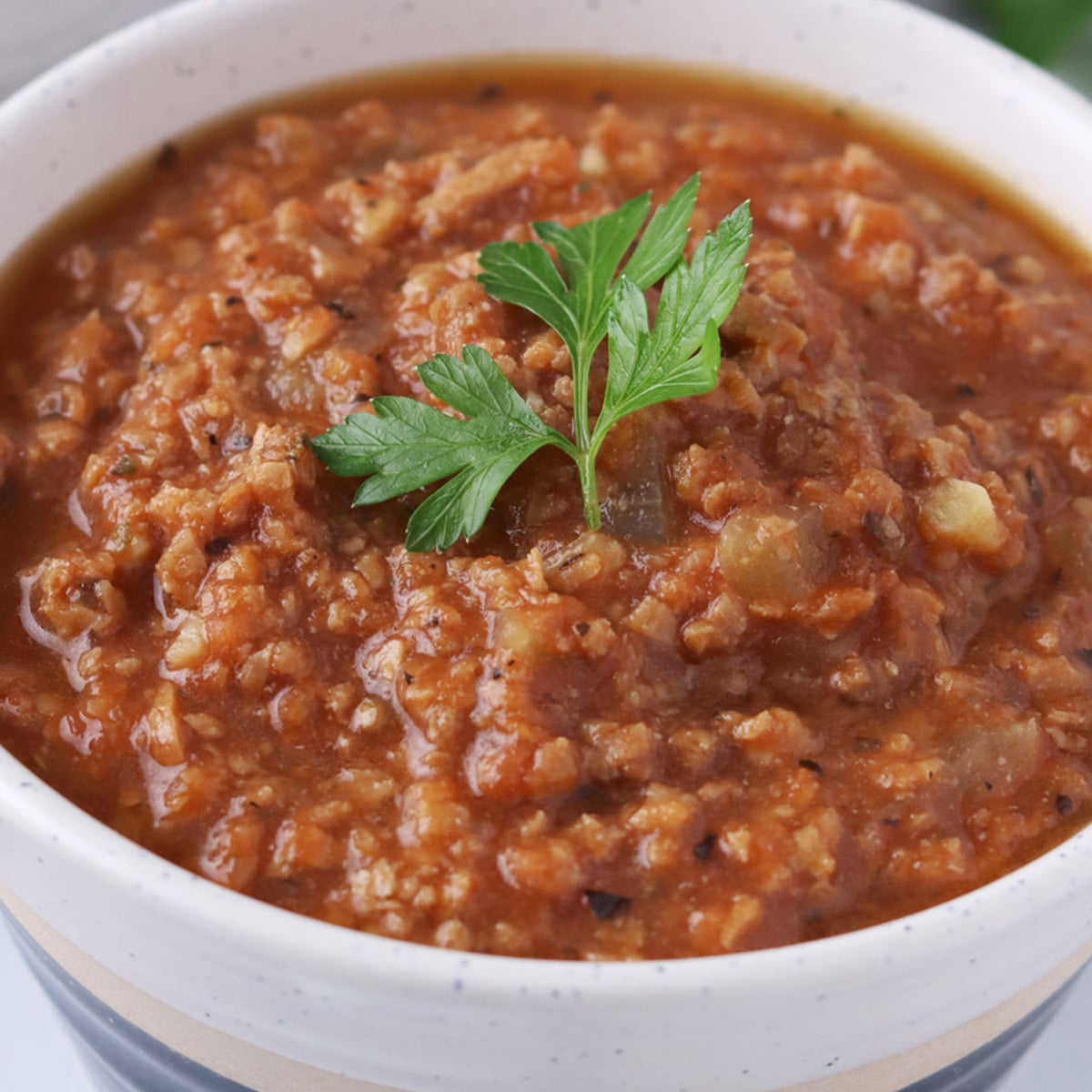
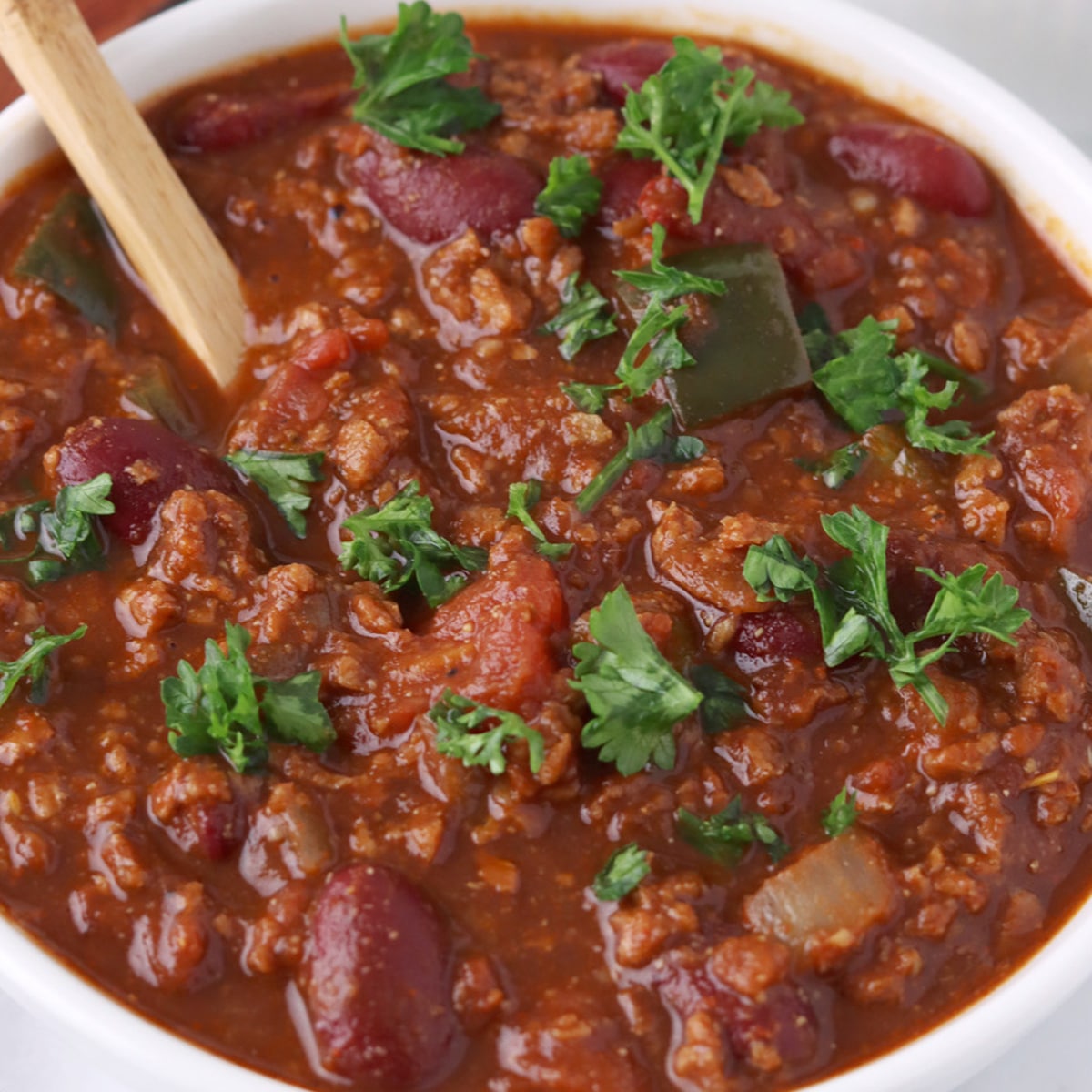
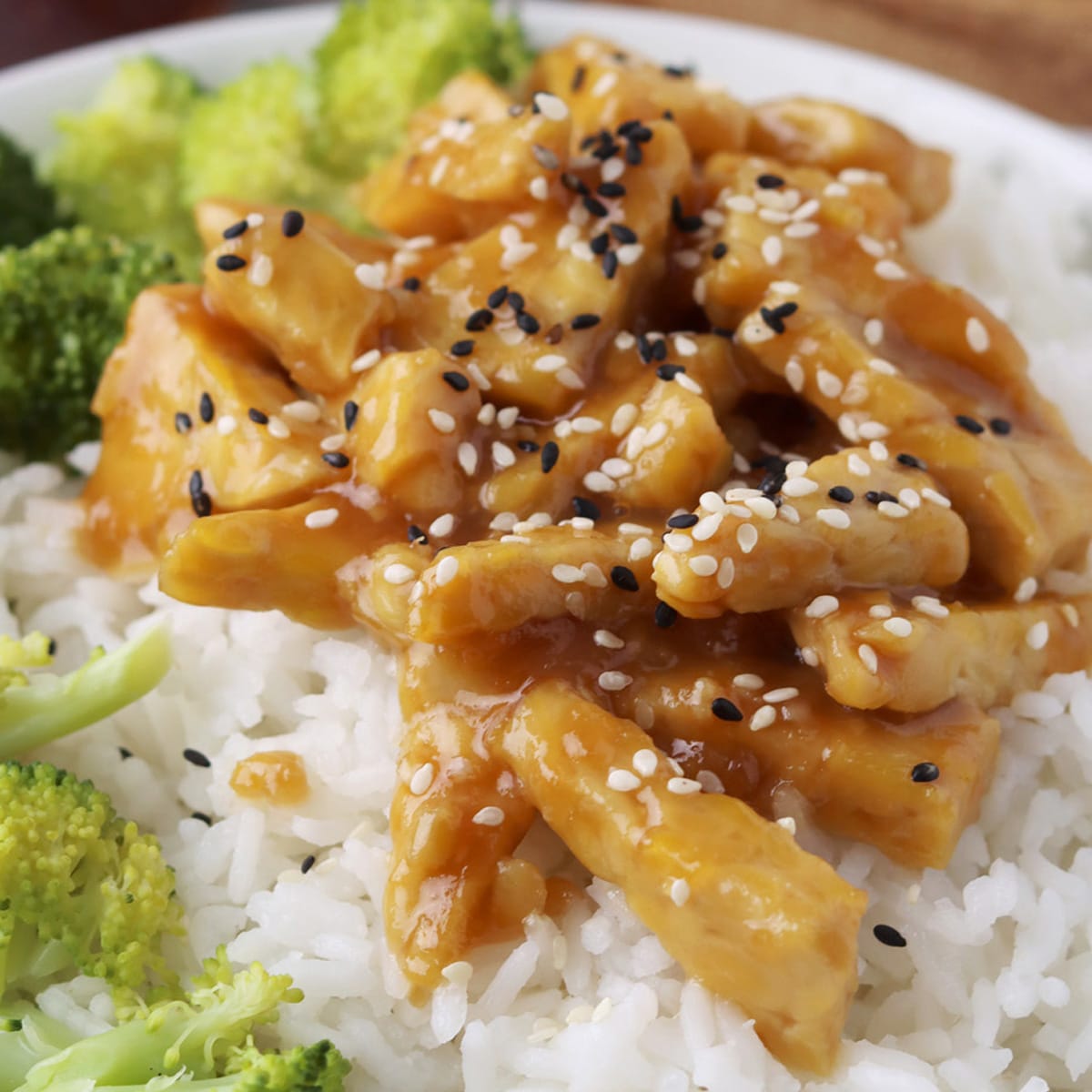
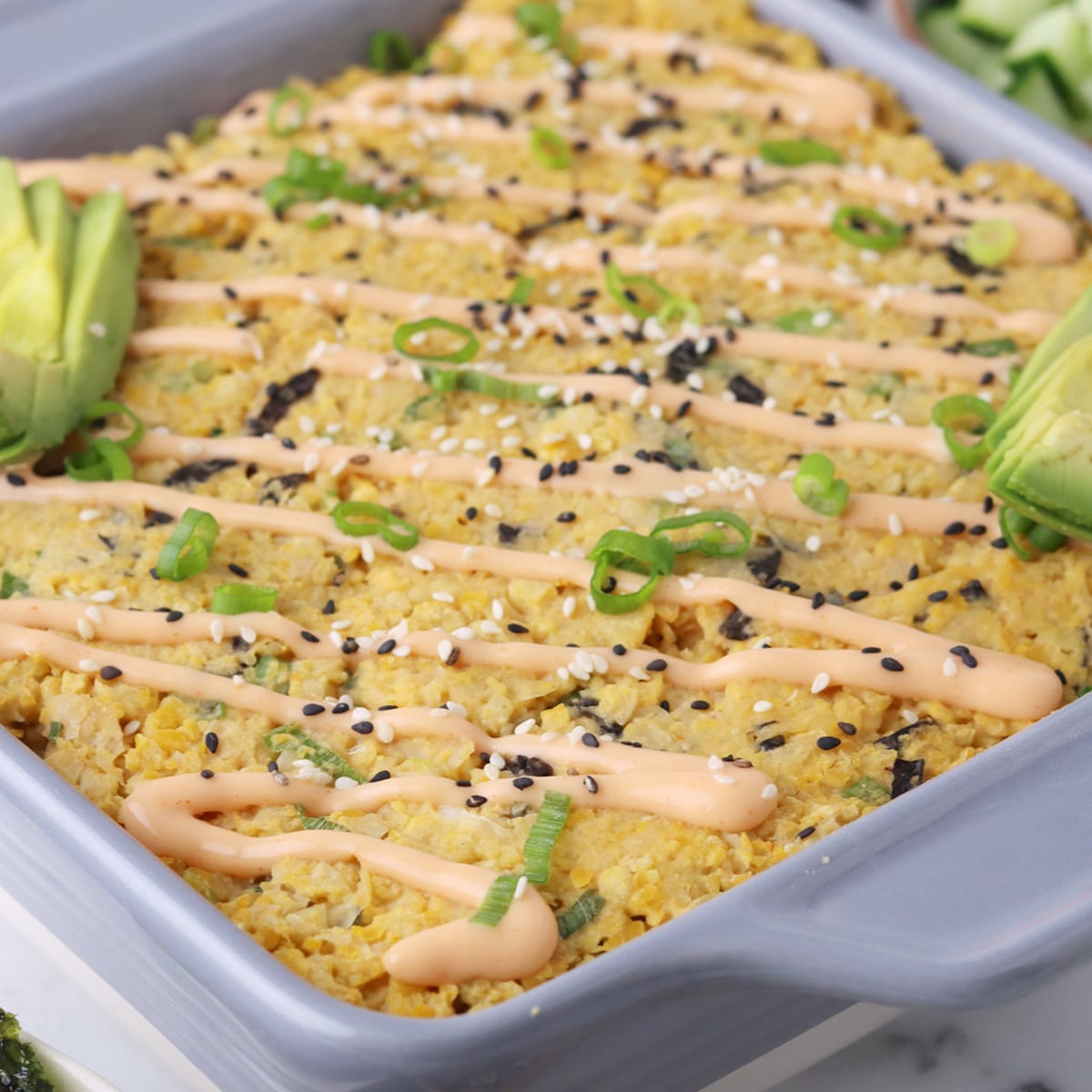
Lola says
Just found this recipe. really good! Great texture and flavor.
I appreciate how directions are laid out, so you don't have to keep going back to ingredients list. you are clearly more professional than the average veggie mom-type post!
I think I'll cook 10 minutes less next time, and add extra smoked paprika.
Nicole says
Glad you enjoyed the recipe and thank you!
Marcus Flores says
Thank you so much for this recipe! Just made it today and my family loves it, I refrigerated it for 2 days before cooking and the texture was nice and firm. The glaze is also very nice addition of flavor.. Will definitely make again!
Nicole Stevens says
So happy you and your family enjoyed! It's certainly a favorite around here 🙂
Edy says
First time I’ve cooked with vital wheat gluten, it was very simple. The roast came together well but I would leave out the smoked paprika next time I felt it was too strong. I used a bit extra vital wheat gluten because I thought the mix was too wet but it made the roll too dry, so next time I’ll stick to the recipe. I will make it again 👍
Nicole Stevens says
So happy you found this to be an easy recipe. I'm a huge fan of smoked paprika but please leave it out or use less if the flavor comes through too strongly 🙂 I just made this again yesterday and also thought the dough was a bit too moist but it turned out perfectly so that's a great thing to point out, thank you!